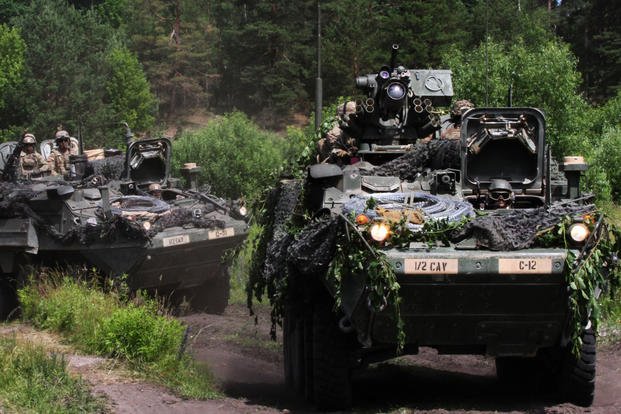The U.S. Army has begun field testing the Common Remotely Operated Weapon Station-Javelin (CROWS-J) atop its Stryker vehicles in Europe, a top official involved with the program said Wednesday.
The 2nd Dragoons, an active-duty Stryker infantry and cavalry regiment, conducted its first CROWS-J live-fire exercise last week, said Col. Thomas Hough, commander of the 2nd Cavalry Regiment.
Conducted during a gunnery training event, the CROWS-J tests "were three-for-three … hitting their targets anywhere from 1,200 to 1,500 meters," he said at the annual Association of the U.S. Army Annual Meeting and Exposition.
Army officials said follow-on testing and fielding is expected to move fast. Lt. Gen. Christopher Cavoli, head of U.S. Army Europe, recently told Army Times the service plans to distribute more than 80 CROWS-J systems across the 2nd Cav, one of the Army's two maneuver brigades, before 2019 begins.
Related content:
- Army Weapons Tests on the Fly in Effort to Win Race Against Russia
- Army, Marines to Buy Thousands of New Binocular-Style Night-Vision Goggles
- AUSA Conference
The fast-paced testing also applies to the Dragoon version of the General Dynamics Land Systems-made Stryker Infantry Carrier Vehicle upgunned with a 30mm cannon.
In August, soldiers assigned to the Bemowo Piskie Training Area outside Orzysz, Poland, conducted the first live-fire exercise using the 30mm cannon in a "supportive maneuver," Hough said. The 2nd Cav received its first upgunned Stryker last December. Months following the arrival, squads were working to smooth kinks to more effectively use the gun, officials said during last year's AUSA show.
"We had them go and establish a support by fire in support of one of our infantry companies, maneuvering on a trench both day and night," Hough said. The exercises became three-day, three-night maneuvers to aim for targets at roughly 600 meters, he said, adding that testing the system lasted six days.
Enlisted soldiers continue to be the "subject matter experts" in this process as they provide feedback after testing the system, added Command Sgt. Maj. Steven Brown of the 2nd Cav.
Leaders found that the 30mm cannon "provides precision, lethal, anti-armor fires in direct support of a dismounted infantry force moving to seize an objective," Hough said.
As Russia continues to test and advance its own equipment, using both the 30mm cannon and CROWS-J systems on Stryker vehicles will give the Army more clarity on how the service can best fight in future conflicts, he said.
Hough said the upgrades could potentially model future formations.
"Does it change how we fight the formation?" he said. "Does it change how a potential adversary would fight the formation?"
-- Oriana Pawlyk can be reached at oriana.pawlyk@military.com. Follow her on Twitter at @Oriana0214.










